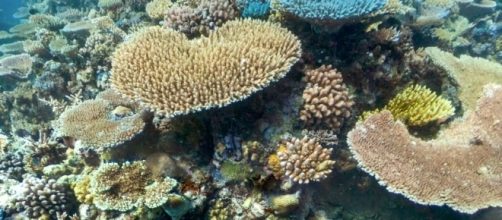After numerous media reports said the Great Barrier Reef was dead from climate change, reef divers wanted to correct the record: coral bleaching doesn’t mean death. Last month, researchers led by the ARC Centre for Excellence for Coral Reef Studies said that many regions of this natural wonder were dead and global warming was at fault. Now they’re back with even more dreadful news.
The government-funded ARC group, led by Professor Terry Hughes, recently completed aerial surveys to determine if the damage was centralized or spread across the 1,400-mile-long structure.
The group was also behind many of the misleading headlines sounding the reef’s premature death knell last month. Bleaching, as many experts point out, is not the same as mortality, and can’t be determined from the cockpit of an airplane.
The surveys that Hughes conducted can’t distinguish what caused the ghosting of the corals. To determine the cause, divers need to do an up-close examination to determine if the bleaching was from storm damage, crown-of-thorns starfish (their number one predator), sea level rise, or warmer water. The flyovers actually indicate the most likely cause was from low tides and falling sea levels.
Falling Sea Level: The Critical Factor in 2016 Great Barrier Reef Bleaching! https://t.co/HyfRgT51Qh pic.twitter.com/rTTqzMlp7i
— Watts Up With That (@wattsupwiththat) April 5, 2017
Bleaching doesn’t equal death
Aerial surveys also can’t determine if the coral is really dead.
That's what divers, who run and own tour operations on the reef, are worried about. The executive director of the Marine Park Tourism Operators Col McKenzie said that some sites frequented by tourists have been hit hard by bleaching and emphasized the coral wasn’t dead and would likely recover.
“People are equating bleaching with death,” McKenzie told Australia’s Cairns-Post. “Well, it doesn’t quite work that way.” Because coral lives a few feet below the surface, aerial surveys don’t capture the full extent of a reef’s health, giving a false impression of widespread ghosting.
McKenzie said Far North Queenslanders need to let other people know what the true effects of bleaching have been, noting the last two years’ warmer-than-normal seawater has affected the coral.
That was caused by a powerful, naturally occurring El Nino that elevated sea surface temperatures in the tropical Pacific. Queensland’s Sen. Malcolm Roberts also tweeted out this well-known fact:
Humans cannot control the temperature of the oceans or El Niño events and therefore #GBR bleaching is a natural event. #empiricalevidence https://t.co/zwxl1KtKq8
— Sen. Malcolm Roberts (@SenatorMRoberts) April 10, 2017
Bleaching a natural event
McKenzie also said they haven’t seen much mortality between Cairns and Townsville, despite scientists saying it had experienced the most damage. The ARC surveys showed this year’s bleaching event affected the northernmost and central regions of the reef, similar to last year’s bleaching, which also affected the northern part of the reef.
The southern tracts showed little to no bleaching.
Dr. Russell Reichelt, chairman of the Great Barrier Reef Marine Park Authority, said the aerial surveys indicated the bleaching was “patchy and there were many reefs that remained largely unaffected.” He reiterated as well that bleaching was not the same as death, and that the reef was likely to recover. That assessment was based on prior bleaching events where over 98 percent of the coral recovered.
The GBR is millions of years old and has survived multiple ice ages, the Medieval and Roman Warm Periods, geological disturbances, and dramatic changes in sea levels and salinity over its long history. Without a doubt, the reef will be here for another million years, even after its many obituaries have long been forgotten.

